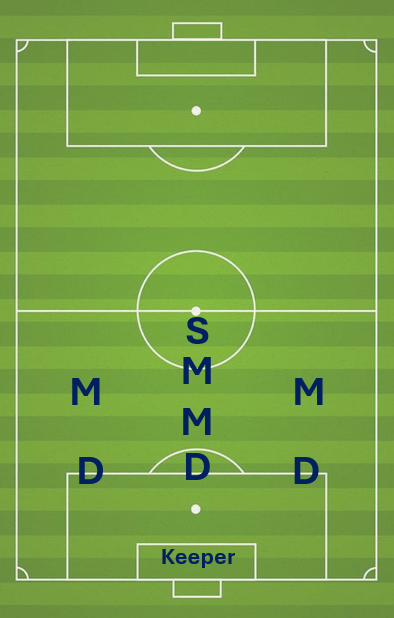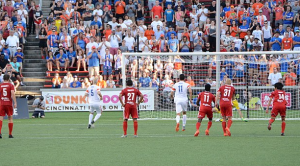
The Hidden Geometry Behind Team Shape
If you’ve ever watched your team stretch across the field and thought, “We look organized… but are we?”, you’re asking the same question researchers are now quantifying. A 2025 Scientific Reports study from Northwestern University and the Portuguese Football Federation uncovers a deceptively simple metric that could change how we analyze and train for team shape in soccer.
The researchers call it the Layer Ratio (LR)—and it might be the most intuitive geometry lesson a coach will ever need.
The Rubber Band Test: Visualizing Team Shape
Imagine you wrap a rubber band around all your outfield players. That’s your outer convex hull—the full area your team occupies. Now imagine another, smaller rubber band wrapping only the players inside that shape—your inner convex hull. The Layer Ratio is simply how much of the outer area is filled by the inner one.
It’s a single number between 0 and 1 that summarizes how compact, connected, and balanced your team is—without complex math or abstract heat maps.
- Low LR (close to 0.2): Your team is spread wide. The “inner” players—often midfielders—are tucked deep, leaving gaps between lines.
- High LR (closer to 0.5): Your team is compact, with interior players nearly as advanced and aligned as the outer shell.
Across 12 matches from the UEFA Euro 2016, 2018 FIFA World Cup, and Euro 2020, the authors analyzed full tracking data for one national team. Regardless of whether the team was attacking or defending, or whether possessions succeeded or failed, the LR consistently stayed below 0.5.
In other words, teams rarely occupy more than half of their own available “geometric space.”
Why This Matters for Coaches
In practical terms, the LR tells you how effectively your team fills its formation—not just where players should be, but how they actually move together as a living system.
- Too low: Players are stretched. Passing lanes widen, but defensive recovery slows. Think of a team chasing long diagonals with gaps between midfield and attack.
- Too high: Players bunch up. Transitions bog down. It’s like trying to play tiki-taka inside a phone booth.
- The sweet spot (~0.3–0.4): Compact enough for support and press resistance, yet spacious enough to switch play.
This ratio’s stability—unchanged across different matches and tournament stages—suggests something deeper: elite teams naturally regulate their collective spacing, whether consciously or not.
From Data to Drills: 4 Takeaways for the Training Ground
- Track Cohesion, Not Just Possession
Instead of relying solely on passing accuracy or expected goals, add a simple positional layer metric. GPS or drone footage can estimate outer vs. inner spacing.
→ Ask: When we progress the ball, do our inner players collapse toward the ball or maintain balance across the shape? - Design Small-Sided Games That Manipulate the LR
Play 5v5s where one team earns points for expanding (low LR) and another for compressing (high LR). Players begin to feel spacing, not just see it. - Monitor Fatigue Through Shape Decay
Late in matches, tired teams lose synchronization—outer players drift forward or back, inner ones stop adjusting. A dropping LR may flag this earlier than the eye test. - Bridge Analytics and Intuition
You don’t need a supercomputer to apply this. Even a whiteboard can model layers: draw your outer line (defenders and wingers), inner line (midfield), and note how they breathe in and out with transitions.
Beyond the Numbers: Style, Identity, and Adaptation
The study notes that while 0.5 seems to be an upper limit, that doesn’t mean tighter is always better. High-pressing systems might intentionally shrink their layer ratio to suffocate opponents, while counter-attacking teams may prefer larger LRs to stretch play and exploit space.
Formations matter too. A 3-2-2-3 might show a multi-layered geometry (even three convex layers!), while a 4-4-2 tends toward symmetry.
Coaches can start using LR as a fingerprint of tactical identity—how a club wants to occupy the field, not just how it does.
And here’s the beauty: the metric scales. Youth academies can measure whether U13 sides maintain relative spacing similar to senior squads. Analysts can benchmark “team geometry efficiency” just as they now do pressing intensity or expected threat.
Your Turn to Kick It Off
This “hidden geometry” reminds us that football is more than running and passing—it’s collective movement shaped by invisible math.
You don’t have to be a data scientist to use it; just a coach curious enough to ask, How do we move together?
Ask yourself and your team:
- When we press or build out, what does our layer ratio feel like—open, closed, or balanced?
- Could different LR targets help us shift from defense to attack more fluidly?
- How might your youth or women’s team’s “team shape signature” compare to professional benchmarks?
Soccer’s next big revolution may not come from a new formation—but from finally understanding the geometry already beneath our boots.



